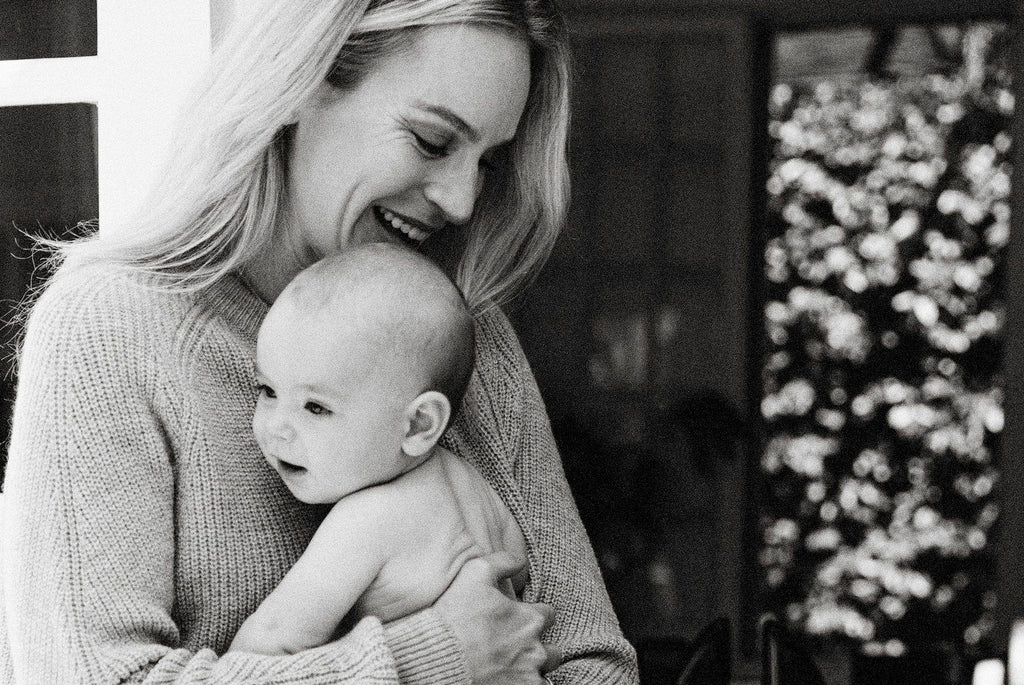The Daily Bloom

Your Survival Guide: Becoming a Father

It takes two to tango and we couldn’t have done it without our male counterparts.
Sure, childbirth can seem to be mostly about the mother and child, but the father is there on the sidelines — literally from inception — being the biggest cheerleader.
With gender roles changing and more and more families evening up the responsibilities between work and family, never before have fathers been so hands on. For this new role as “dad” there is much to learn, so in honor of our baby daddies we’ve made a New Father’s Guide to everything you’ll need to know after bringing your little one home...
Practice patience --
After giving birth, women’s hormones are shifting greatly which can cause strong emotions and mood swings. By being understanding, encouraging, and listening to what she needs you’ll better be able to serve as the rock she longs to lean on.
Baby proof the home --
The two of you have probably spent the last few months making sure the home is baby ready, but there are always those undeniable last minute loose ends to tie up. Whether it’s a quick touch up, a paint job, or going through (again) and rounding out all the sharp corners in the house, this will be a huge relief for the mother coming home from the hospital.
Help, help, and then help again --
Constantly ask how you can lend a hand. Learn how to change diapers, swaddle, and bathe the baby. Learn how to prepare a bottle, how to store breast milk, and volunteer to wake up in the middle of the night for feedings to let her sleep. (Babies wake up hungry about every 2-3 hours.) Take walks with the baby, learn their cues, connect through skin-to-skin contact, talk to him or her, and spend one-on-one time as a father and his child have an undeniable connection.
Take on cooking duty --
Research post-pregnancy diets and the right kind of food for a woman to eat while she recovers. Foods ideal for postnatal recovery include leafy green vegetables, Swiss chard, avocado, fish, sweet potato, whole grain cereal, oatmeal, eggs, and fruit. Breakfast in bed and home cooked lunches and dinners (sans grocery store runs) will allow for the new mother to concentrate on herself and the little one.
Don’t put too much pressure on each other --
This period is the start of a new chapter in all of your lives, so you must realize that life isn’t going to be exactly the same. There will be much trial and error while you navigate the changes as a family, but the most important thing is to be flexible, listen to each other, and work together.
Tell her she’s beautiful --
Her body has been through so much during this time and has created a human being that will forever be a part of your lives. Maybe she’s going to bounce back to her pre-pregnancy body right away, or maybe it’s going to take some time, but either way, be there to praise it, honoring what it’s done every step of the way. Everyday tell her she’s beautiful, amazing, and sexy -- and make her believe it, because she is.

Your Survival Guide: Everything a New Mama Needs
For the past 10 months your body has been going through the most changes it’s likely had since its own turn as an infant. And, like it or not, once you’re back home from the hospital with a baby in tow, everything doesn’t just bounce back to normal life like nothing ever happened. This fourth trimester is a gentle time, to be taken slow and easy. It’s a chapter where you and your baby are both learning about each other, so enjoy it and don’t rush -- your new way of life will mesh together with your old soon enough.

The first six weeks after coming home are a time of recovery where you should focus on letting your body mend itself. Soreness, bleeding, aches, and pains are common so keep ice packs, heating compresses, and menstrual pads close by for relief. Use this time for self-care and reward yourself for a job well done by enjoying massages, taking baths, drinking water (it helps with milk production), shopping for a new postpartum outfit, and sleeping as much as possible.
You want to get back in shape, but don’t try jumping right back into your old workout routine. Rather, do a gentle postpartum yoga class at home or go outside for a walk around the block, giving your legs a much needed stretch. Your baby will enjoy the new scenery and the fresh air will be good for the both of you to strengthen your immune systems together.
Throughout these first weeks at home there will, no doubtedly, be lots of trial and error, so learn to go with the flow and be flexible -- and whatever you do, don’t stress (babies can sense stress which will make them more fussy).

Lay down a strong foundation with your partner or a loved one to ally up and undergo these transitions as a team. Together, come up with a plan of what they can do to help (this could be diaper duty, swaddling, night feeds, or simply taking the baby on a walk to give yourself a break -- or a nap). Asking your partner to be extra patient, supportive, and encouraging during this time is also important as this is a very emotional time for a new mother as her hormone levels are still adjusting.

Even though romance might be the farthest thing from your mind, it’s important to still spend quality time with your partner so the two of you can catch up on the non-baby areas of your lives -- even if it’s just putting the baby to bed early to fall asleep on the couch together while (attempting) to watch a movie. It will mean a lot to your partner to be acknowledged as your lover, as well as your teammate in baby raising.
To aid your body and mind in recovery, focus on eating healthy meals, using foods that are ideal for postnatal recovery like leafy green vegetables, Swiss chard, avocado, fish, sweet potato, whole grain cereal, oatmeal, eggs, and fruit. If cooking is about as foreign to your partner as your baby’s umbilical cord was, opt for a meal delivery service. Depending on where you live there are different options that will work with your dietary restrictions and can often be delivered directly to your door.
Use this special time to rest and relax -- you don’t have to be a superhero. You’re learning how to mother a new baby in the world, so relish in it… even at 4am.

OB-GYN, Midwife, or Doula — Which Works Best for My Needs?

Childbirth is a very personal matter. It’s between you and the life you and your partner have created over the last 9-10 months. But that doesn’t mean you don’t need help...
They say it takes a village to raise a baby, and that starts at day 1. From obstetrician-gynecologists (OB-GYNs) to midwives and doulas, there are many different qualified professionals who can lend their very capable hands throughout this new chapter.
All are valuable in different ways, so it’s up to the individual whom they would like to choose to take part in this experience. If what you’re desiring is a more traditional birth in a hospital with a highly qualified physician, an OB-GYN is what you’re looking for… or maybe it’s a quieter at-home experience with a midwife and/or doula that sounds more up your alley.
In an effort to make the decision a bit easier, here is what, exactly, each birthing provider does and how they can best fit with your needs...
OB-GYN
Chances are you’re probably already familiar with an OB-GYN, a physician who specializes in women’s reproductive health (think annual pap smears and STI testing), and also who is trained to monitor women’s pregnancies and deliver babies. Women usually start seeing an OB-GYN around the age of 13-15 and then about once a year for a well-woman visit once they become sexually active. Throughout your pregnancy you’ll meet with your OB-GYN multiple times at different milestones in the babies gestation (weeks 4-28: 1 visit a month; weeks 28-36: 1 visit every 2 weeks; weeks 36-40: 1 visit a week). They will be the one to actually deliver your baby, so it’s important to select a physician you feel comfortable around.
Midwife
A midwife has medical training and is trained to manage normal pregnancies, focusing on the baby’s needs specifically. If an emergency situation arises they will recognize it and pass over the reins to a more qualified provider, like an OB-GYN who is trained to handle high-risk pregnancies and surgeries. There are various types of midwives from registered nurses to those who have bachelor’s degrees in health related subjects to those with specialized training specifically in midwifery. Like an OB-GYN, a midwife can do prenatal and gynecological exams and order testing, administer prescriptions, help make birth plans, perform fetal monitoring, offer advice on planning, exercise, diet, and meds, as well as actually deliver the baby. Typically, midwives are more prone to using natural interventions than an OB-GYN who often relies on textbook medical training. Some hospitals allow midwives to come assist, while some ban it, so if the hospital route is the direction you’re leaning, it’s always a good idea to first check the rules of your desired health center.
Doula
Aptly, the word “Doula” derives from the Greek word meaning “woman’s servant.” Doulas are professionally trained (but not medically trained) providers who focus solely on the mother and her needs before, during, and after childbirth. They are there to offer emotional, physical, and educational support and to do all that they can to help the mother have an empowering experience. Through techniques like meditation, breathing, and massage they will ensure their patient maintains a sense of calm, regardless of whether it be medicated or natural, at home or in-hospital. There are birth doula’s that provide support during labor, antepartum doulas who help prepare for birth, and postpartum doulas who help nurture the family at home as they transition into a new chapter with their newborn. Assistance with diapers, bathing, breastfeeding support, soothing techniques, and helping to locate local resources such as parenting classes and support groups are all common areas where doulas lend their aid. It is the doula’s mission to lend support to the whole family, not just the baby -- truly, a woman’s servant.

Your Survival Guide: The First Few Weeks

Babies thrive on routines, and sticking to a strict schedule can make all the difference.
While it will take some time to find the patterns and rhythms that work best for you and your child (what works for some doesn't necessarily work for everyone), nailing down the process will be worth it. The earlier you start focusing on routines the better, as your baby can start picking up on good habits right away.
Here is our survival guide to the first few weeks, divided into categories…
A survival guide to sleeping
Look for sleeping cues from your baby like yawning, stretching, watery eyes, or fussiness. When you notice these signals it’s your baby’s way of telling you that they are tired. Don’t wait until the baby is actually asleep to put it down, but rather create naptime when it’s still awake but feeling sleepy -- this will train your baby that it doesn’t need to use tears to convey what it needs.
When putting down for the night or naptime, remove the baby from as much stimulation as you can to find a quiet, calm, consistent, and peaceful place to rest. Like when they were in utero, babies like it completely dark, snug, and warm. To recreate an environment that is similar to the womb, installing black shades in the nursery will be helpful, as will swaddling the baby in a bassinet surrounded by the constant humming of white noise (it can get up to 96 decimals in the womb!). Keep a baby monitor close by so you’ll be able to keep a watchful eye when you’re in other rooms of the house.
Newborns tend to sleep in three hour increments a day (and night). When they wake up they’ll be hungry and want to feed, and then they’ll want to sleep again -- there’s no set time or training at this age. However, tracking their sleeping patterns in a log book will help you better understand your baby’s natural habits.
Once they get to around 3-4 months (or 14 pounds), it’s a good time to move them from the bassinet to the crib and start sleep training by setting a bedtime and healthy sleeping habits. At this time you can create more structured routines like a relaxing bath in dim light before bedtime and a morning routine of bright light, lively music, playtime, and, of course, breakfast.

A survival guide to feeding
When it’s time to feed excuse yourself to a quiet and comfortable place if possible. Like when they are sleeping, babies like it dark, so if the option is available feed in the same place they normally go down. Keep the baby warm, dressed in layers or wrapped in a blanket with the room around 73 degrees F.
After the first week the baby will be able to latch well, so it’s a great time to introduce a bottle. Babies should eat roughly 2.5 ounces x their weight per day, and by giving them a bottle you’ll be able to monitor their intake, taking note of how long it is taking them to fill up so you’ll have a better idea of how long they should be spending on each breast.
Try to feed every 2 hours, but if they are crying it means they are hungry so go ahead and feed again. Cluster feeding (feeding at shorter intervals throughout the day) is an option if the baby is tending to want more, more often.
While feeding, the baby will oftentimes have a preferred side automatically, so make sure to rotate the baby’s head with each feeding to prevent it from getting a flat head or from one side becoming stronger than the other. Also take note of this when the baby is lying down for tummy time and while in its bassinet or crib, careful to rotate the sides evenly.
Pumping is important for many reasons, whether you’ll be away from your baby for a period of time or are trying to increase your milk supply and alleviate pressure. A good time to pump is first thing in the morning as most moms tend to get the most milk then. Pump a half hour to an hour before or after nursing.
A survival guide to diapers and digestion
During and after each feeding the baby will need to be burped to prevent reflux. Every 15-30 minutes hold the baby up in front of you so it can burp. Tummy massages will also help the baby’s flow become more regular. As their body transitions and adjusts to the outside world, the texture of their poop will change which can be uncomfortable for them. Rub and apply pressure to their stomach while raising their legs and moving them in a bicycle rotation to help alleviate any pain.
Newborns should have their diapers checked every 2 hours or so as they’ll usually poop with every feed.
When changing diapers always wipe from front to back and put a clean diaper underneath the old before you change. Prevent moisture with ointment and use new wipes for each swipe, taking note every time to clean the creases. Once they get to the 3-4 months stage and are sleep training, double down on diapers each night to encourage longer sleeping sessions. (Babies should be good for around 8-12 hours in the same diaper while sleeping at this age.)
A survival guide to bathing
Sponge bathe the baby when it first comes home in a newborn bath tub, being gentle around the belly button stub (which can take up to 2 weeks to fall off). Once your baby is 3-6 months and they’re starting to hold on to things, have steady heads, and pull themselves up, they can move to actual baths in a sink or toddler tub. Bathtime will relax the baby’s muscles and facilitate a longer state of sleep.
Bathtime is also a good time for skin-to-skin contact which should begin as soon as the baby is born. This is a great way to bond, as they already know your smell and voice from their time in utero.
Create a nighttime routine of mellow, relaxing music as you give your child its nightly bath. Keep the lights dim and limit playing so they register that nighttime is for winding down and sleeping. In the morning the fun will begin... again.

Carving Out Time for Dinner with the Culinistas' Tiana Tenet
When Tiana Tenet found herself slaving her days away in the New York grind surrounding Wall Street she knew it was time for a career change. Stemmed from a passion for eating healthy (and often not having the time to create nutritious home cooked meals), she teamed up with business partner Jill Donenfeld in 2017 to create The Culinistas, a cooking service whose mission it is to bring people back to the table and make it easier to enjoy home-cooked meals together.
The service pairs families with local chefs who then come to you -- with groceries! -- to cook your meals for the week (they clean up too)! Food is sourced from the local farmers market, with free-range meat and sustainable and organic ingredients.
We caught up with the entrepreneur to ask her to share a little about her life at home (and at the dinner table)...
What is the one lesson you’ll teach to your kids?
The importance of gathering around the table to engage in meaningful conversation and enjoy delicious food.
What are you eating these days?
Eating? You mean drinking! Between the water, coffee, milkmaid tea, smoothies, and wine, I find myself drinking all day. The water, tea, and smoothies help with milk production. The coffee and wine help with motherhood!
What is your all-time favorite recipe?
My mother's sausage bread. It's a family recipe she perfected and passed down to me. I make it during the holidays or on a rainy day.
What is your go-to meal for your children?
Whatever my husband and I are eating. We believe strongly in family meals -- it's the best way to introduce new foods to your children and expand their palates.
How do you practice self-care?
I love to move. If I can't fit in an intense workout, I'll squeeze in a walk to work or stroll around the neighborhood while taking calls. On the weekends, I'll swap out my workout for a tennis match or dance session. Moving brings out the best in me!

8 Questions To Ask Your Medical Team Before Giving Birth
Hospitals exude anxiety. They make people nervous. And they can be confusing, to say the least. When mixed with medical jargon that often sounds like an entirely different language and complex procedures you can hardly believe, stepping foot inside the sterile white walls of a doctor’s office (or labor and delivery room) can feel completely foreign.
When preparing for childbirth, rules, regulations, and hundreds of where/when/why/and HOW? questions make up an array of knowledge akin to taking a college course in med school. And then after, with a precious newborn baby added to the mix, it can suddenly seem as though all the hard-work you’ve done pre-baby -- all the books you’ve read and preparation and advice you’ve gleaned -- seem to have gone in one ear and out the other.
Fret not. There are ways to combat the nerves that come with these 9 long months. Before every hospital visit, take a moment to connect and listen to your baby, making a list of all the questions you may have. Keep this list close because questions will come to you when you least expect as you’re navigating through your daily and nightly routines. This way, you’ll be armed with a roster of armor at your next appointment and won’t leave any question unasked.
When communicating with your medical team, it’s important to be as clear and honest as possible so they can determine how best to treat and diagnose your complex and individual conditions. Be your own advocate because no one knows you like YOU. If there’s something you don’t understand, ask. If there’s something you disagree with, tell. This is the time to gather all the information possible so you can feel informed and empowered to make the decisions and choices that are right for you, personally.
Here is a list of questions to ask your medical team that will better prepare you for your upcoming hospital stay…

What are the names and positions of each member of your medical team?
Doctors, nurses, advocates, and social workers are all there to help navigate your experience and each have a different expertise that can help better your stay. In addition to your core team of various doctors and nurses, make sure to utilize other help like nurse advocates who can guide you along the learning curve, and hospital social workers that will aid with insurance and billing.
How many people can be in the delivery room with you?![]()
It’s smart to ask this question ahead of time, so you can inform loved ones of the particular hospital’s rules, as they are all different. This is also a good time to think about who you actually want to share your experience with because it’s going to be one of the most personal and intimate experiences of your life… so maybe it’s not for the hospital’s newest doctor-in-training or your third cousin by marriage, after all.
During labor, should you eat and drink?
Depending on the hospital and the individual’s birth plan, there might be different guidelines. Some allow eating and drinking, while some recommend against it completely in case of complications and the (far out) possibility of needing anesthesia.
Where can you walk? What laboring positions are recommended?
During labor you’ll be feeling very uncomfortable, so it’s important to do everything you can to try to mitigate this. Walking helps ease tight muscles and lower stress levels, so ask what parts of the hospital are conducive for a very pregnant lady to be strolling, as well as the best laboring positions for both standing, sitting, and lying down.
Is there a shower?
Because it lowers adrenaline and encourages endorphins, warm water soothes pain sensors and helps with relaxation, so noting whether or not there is a shower or bath available to use will be an effective method of pain relief.
What is the pain plan?
Write down a birth plan and share it with your team. Do you want a natural birth or are you going to use an epidural? If it’s the latter, at what point should it be administered? What are your pain numbers? Are you a lightweight regarding medication? Have a team member walk you through all the options so you know what to expect -- and be honest with what you’re expecting so they know how best to handle your needs.
What newborn tests will be given after birth, and are any optional?
There are a number of general tests administered to newborns upon birth, so it’s important to educate yourself on which of those are absolutely required and necessary, and which can be opted out of. Discussing this beforehand will save you (and baby) some uncomfortable surprises.
When can you leave?
Although it will vary by individual, ask for a general timeline of when it will be safe to leave the hospital, taking note of the protocol required. This will better help you -- and your partner and loved ones -- prepare for the baby’s homecoming. Soon it will be time to bring your new addition home to begin your shared lives together!

How to Decide Whether or Not You Want an Epidural
Epidural blocks vs. natural birth?
It’s the question every mother debates as each trimester passes. To some, it’s a no brainer. There is absolutely no way they are going to go through that much pain and anxiety voluntarily. While to others, the pain is just one part of the birthing experience, something they will remember forever.
While injections of localized anesthesia allow for a painless delivery so a new mother can better appreciate the life they are being introduced to, natural births are attractive to many who don’t want to introduce any sort of unnatural drugs to their baby, whatsoever.
Either way, there needs to be plenty of research involved to factor in all the options and to properly understand the benefits and risks of each. Signing up for birthing classes will give you and your partner a good idea of what to expect, as will asking your doctor specific questions. (Write them down before going in for your appointment as it’s easy to forget in the sea of information you’ll be given).
Now, let’s focus on the pros and cons of each option...

Epidurals
An epidural is a form of spinal anesthesia that increases comfort by relieving pain from the waist down so that contractions don’t feel so fierce. According to a 2018 study by Stanford Medicine, 71% of pregnant women get epidurals or other spinal anesthesia.
Because pain starts in your uterus and travels via the nerves in the spine or backbone, when the epidural is delivered to the base of the spine, intense sensations are prevented before they reach the brain.
Epidurals can be delivered in a few different ways.
A regular epidural is given through a catheter and then taped to your back, staying for the duration of labor. This option can last for as long as 24-36 hours and makes it so small amounts of the medicine may be given throughout labor as pain calls for it, focusing on the various areas that may need more attention.
A combined spinal epidural (CSE) or “walking epidural” is a lower-dose option which uses smaller amounts of drugs and is administered through a single needle into the spinal canal via the lower back (typically lasting between 1.5-3 hours). Lowering pain, but not to the point of being totally numb, this is an option many expectant mothers prefer so they can still feel and be in control of what’s going on while maintaining a certain level of comfort.
While both types of epidurals provide relief, it’s important to know that they aren’t instantaneous. They need about 15-20 minutes to start working, and can take at least a half hour to properly arrange for one. (Pre-epidural preparations include labs, an IV, paperwork, a bathroom break, and a consultation with the anesthetist -- so don’t wait until the last minute if you are planning on having one!)
Common side effects for epidurals can include hypotension (lowered blood pressure), nausea, itching, and a sore back. Much more rare side effects can include fever and a spinal headache, which occurs in less than 1% of patients.
While the amount of meds delivered to the bloodstream that will reach the baby is very limited during either type of epidural, the fact that the baby may, indeed, be absorbing some of the drugs is what pushes many mothers to opt for a natural birth.
Natural Birth
Those choosing to give birth naturally feel that fully experiencing your contractions is valuable in that your body inherently knows what to do and will guide itself to move in a way that aids in the birthing process. (In fact, epidurals didn’t become common for pain relief during labor until the 1940’s.)
Some also argue that when labor pains are increased, endorphins are as well, and blocking those pains can also numb endorphins. Additionally, the ability to stay at home longer, to move around free from machines, and to avoid being excessively monitored are all more reasons why women may choose to go the natural route.
Having a doula and taking classes like HypnoBirthing and Lamaze will help a woman (and her partner) learn to practice breathing and meditation techniques to help maximize relaxation. Massages, acupressure, heat packs, and frequent changes in position can also assist in comfort levels.
Other than considerably more pain, the cons of a natural birth can include added tearing in the vaginal wall area, as well as the development of hemorrhoids and bowel issues due to the need for stronger pushing.
While there is no one choice that works for everyone, discussing these options with your medical team and loved ones will help you best prepare for birth. Deciding factors to consider when making the decision should include your overall health and wellbeing, pain tolerance, intensity of contractions, pelvis size, and the size and position of the baby.
No matter what route you choose to go, to avoid disappointment try not to be too hard set on any one idea as things can often change in the heat of the moment. Now, push!

Sakara's Metabolism-Boosting Cinnamon Mocha Latte is Giving Our Mornings Life
Sakara can do no wrong in our eyes. Not only do they deliver some of the best ready-to-eat, plant-rich super meals directly to your door, they also have a variety of supplements in the lineup — everything from super powders to water drops to functional chocolates. Yes, please!
We’ve recently added this metabolism-boosting Cinnamon Mocha Latte to our morning routine which incorporates their Metabolism Super Powder, and — dare we say — our mornings are better than ever!

INGREDIENTS
- 8-12 ounces, freshly brewed organic coffee
- 1/4 cup unsweetened almond milk
- 1 teaspoon coconut butter
- 1 packet of Metabolism Super Powder
- 1-2 drops (about a scant 1/8 tsp) vanilla extract
- Dash of cinnamon
- Optional: 1/2 teaspoon of coconut sugar, or to taste
DIRECTIONS
- | Combine ingredients in a high-speed blender. Be sure the blender is tightly sealed to prevent hot ingredients from splattering. Blend for 30 seconds to one minute, until frothy.
- | Carefully remove the lid, and serve immediately.
Alternatively, combine ingredients in a wide-mouth jar or coffee thermos, and use an immersion blender to combine and froth.


Laura Erlich on Parenting a Teen and Maintaining Balance

Laura Erlich: LAc, FABORM is a Holistic Fertility and Obstetric Specialist who began her career in holistic wellness after studying Traditional Chinese Medicine with an emphasis on fertility and obstetric care. After graduating summa cum laude from Emperor’s college, she founded Mother Nurture Wellness, a Los Angeles based women’s health practice specializing in fertility, pregnancy, and postpartum care.
As an integrative health professional for over 20 years, Laura has helped thousands of families grow by creating a custom roadmap that targets each individual's needs — from nutrition, supplementation, herbal medicine, acupuncture, meditation and beyond.
In 2015, Laura co-authored Feed Your Fertility: Your Guide to Cultivating a Healthy Pregnancy with Chinese Medicine, Real Food and Healthy Living.
Visit her at www.mothernurturela.com or on Instagram at @mothernuturewellness.
What is the self-care practice you do to maintain balance?
I have two practices I can’t live without. One is taking my dogs for an afternoon walk, which is a kind of walking meditation for me and helps me transition from work mode to home/mom mode. The other is long baths. I am fortunate to have a big tub and bought myself an amazing flotation neck pillow and bolster, with some waterproof earbuds. I love to float in the tub by candlelight while immersing myself in binaural beats or a guided meditation.
What is the one lesson you’ve learned that you’ll pass along to your children?
Life is unpredictable, save your money.
What excites you most about being a mother?
My son is a teenager now, and I always thought I’d hold my nose and just get through this part. Much to my surprise, I really love parenting a teen! Of course he has his teen-moments, but all-in-all it’s a joy to watch him blossom into a young adult. I’m so proud of who he is and who he is becoming, and I’m astounded by how enjoyable this phase has been — so far, at least!
Tell us about your child’s name… is there a special meaning behind it?
His name is Sebastian and my husband's name is Sean. Sebastian is a nod to my favorite Shakespeare play, and a name I’ve always loved. After we named him, I realized the first two letters of his name and the last two letters of his name spelled Sean! I like to think that it means his dad always has his arms around him… because he does.
What was your pregnancy journey like and what surprised you the most?
My pregnancy journey was overall pretty good, though I did have some pretty significant sciatica for most of it, which was no joke. I chose midwifery care and a home birth, which really made me feel like I had incredible support and care for my whole self and the baby. And while birth itself was not for the faint of heart, I wouldn’t trade my home birth experience for anything.
How has life changed for you since becoming a mother?
At this point, I’ve been a mom for a pretty long time and life has had countless iterations since this gig started!

What are some examples of how you are different or similar to your own mother?
My mom passed away when I was 17, so it’s taken time to see the similarities without her here to make active comparisons. The older I get, the more I can see how much of a positive influence she had on me, even if it was only for a (way too) small part of my life. I try to honor her memory by being the best mom I can be and by remembering her core values and passing them on to my family.
What is the most useful piece of advice you’ve received about motherhood, and how have you incorporated it into your life?
Years before I became a mother, a friend with two small kids told me that it was “her job to work herself out of the job.” That always stuck with me, and it’s formed the basis of much of my parenting. My husband and I frequently remind each other that we are raising an adult, and we do our best to help him continually take responsibility for himself from a place of knowing that we are always here if he needs us. I feel confident that my son is well on his way to being an upstanding, self-sufficient, and kind person, which I will consider my greatest success in this life.
Have you ever been mom-shamed? How did you handle it?
As the mother of an only child, I have been shamed periodically for not “giving him a sibling.” But I never really let that get to me; it was the right choice for us and he’s a well-adjusted human. Mom shaming is really upsetting to me — everyone is doing their best.
What are you eating these days?
These days I’ve been obsessed with my pressure cooker/air fryer combo. In our house, we eat a lot of warming foods, especially in the winter months. Things I love to make from scratch that my whole family loves include chili, chicken vegetable soup, shepherd's pie, and stir fries. I alway try to source the best quality ingredients and make nutrient dense meals made with whole foods.
What’s your all-time favorite recipe?
I often roast a chicken, which has become known as the “Magic Chicken” because it’s so delicious and easy!
INGREDIENTS
- 1 whole organic pasture raised chicken (about 4 lbs)
- Salt, pepper, garlic and onion powder, thyme
- 4 large carrots
- 4 red potatoes
DIRECTIONS
- | Preheat the oven to 450*. Pat the chicken dry with a kitchen towel. Rub a tablespoon of salt all over the chicken, following with a generous amount of garlic and onion powder. Rub into the chicken until it makes a thin crust. Finish with a sprinkle of fresh pepper and a teaspoon of thyme.
- | Cut the vegetables into 1 inch pieces and place on a high-rimmed baking sheet. Coat lightly with avocado oil or another cooking oil, but do not season. Move the veggies to the perimeter of the baking sheet and place the chicken in the center, breast side down.
- | Cook for 45-50 minutes, stirring the vegetables about halfway through, then remove the chicken from the oven and flip it over to breast side up. Stir the veggies and incorporate the chicken drippings. Return the chicken to the oven and roast for 15-20 minutes more. Check that the temperature is at 165* and remove from the oven. Let it rest for 20 minutes before carving and serving with the roasted vegetables. Magic!
Photo credit: Kate Hauschka

Mom Talk with Chef and Mom-to-Be Tara Sowlaty Lehrer

Mom Talk with Chef and Mom-to-Be Tara Sowlaty Lehrer
Tara Sowlaty Lehrer is a chef, nutritionist, journalist, designer, and creative director -- and one half of the duo behind the wellness site, How You Glow. Regularly sharing her tips on motherhood, fitness, and lifestyle, she is a one-stop-source for wellness that many LA moms have come to count on. We recently caught up with the entrepreneur to ask her a few questions about mamahood...
How do you practice self-care?
I try to weave in self-care all throughout the day. I always start my day with meditation and reading in bed. From there I do my morning routine of brushing my teeth, washing my face, and body brushing. I try to move throughout the day, daily walks outside, eat nourishing foods, and drink water. And I always find time to be cozy and disconnect with my husband and dog.
What is the one lesson that you'll teach to your kids?
I hope to teach our kids self-love and self-confidence, that empathy is the root of all love, and to always lead with kindness.
What excites you most about motherhood?
I’m so excited to experience the expansion of the heart, and see my heart outside my body in my child.
What has surprised you most about pregnancy?
It really is a magical experience! But it’s a lot at once. I didn’t expect to feel so nauseous to be honest, and I didn’t expect to have so many food aversions! As someone who is obsessed with food it was a very weird and challenging experience to dislike food! Luckily that has passed and I’m back to my food-loving self.

Do you have any mom icons?
My mom hands down is my number one mom icon. She is literally superwoman, who is a beyond attentive mom, full time boss and CEO, who handles a million things a day. She is the most loving, generous, supportive mother in the world, and I am constantly in awe of all that she does for others on a daily basis. I can just hope to be half of what she is, and I know that with her by my side I can do anything. She inspires me to be the best version of myself and the best mom I can be.
What are you eating these days?
I’m focusing on healthy fats, proteins, good carbs, fresh fruits, leafy greens, and yummy vegetables. I eat a lot of nuts, good quality dairy, and fermented foods as well. I’m nourishing myself and the baby as much as I can, but still indulging in some of my favorite treats every now and then as well.
What will be your go-to meal for your children?
My cozy roast chicken! I know they will love it. It’s so simple and full of flavor and is the ultimate nourishing meal, made with love.

Hannah Hale Redfern on Becoming a Mother and Starting a Business
As someone who has always been extremely career oriented, I candidly used to look down on women who chose to prioritize their families over their career. I was not born with natural smarts and had to work incredibly hard for my career advancements. I assumed when my daughter was born, nothing would change for me professionally... but that couldn't have been further from the truth.
When my daughter Rowan was born three years ago, everything shifted overnight. While I was so grateful to have her in my life, I remember those early days as some of the most isolating and lonely. Establishing myself as a new mother and building a new support community felt like completely starting over. I wanted to be present in my daughter’s life, but was unsure how to manage that with an all-consuming career. No amount of professional success can prepare you for how to be a mother and balance it all. I began to question what “success” really looked like.
After deep soul searching, I ultimately decided not to return to work. While I do not take this option for granted, it was an extremely difficult time as I looked to carve out my new identity.
As I was working to rebuild my community, I met many similar, like-minded women. Women who were looking to redefine themselves and wanted to balance their careers with raising a family. These women were incredibly talented, but struggled to find careers that afforded them flexibility and the ability to prioritize their families. I wanted to help solve this issue.
At the same time, I experienced a change in something I had always seen as a defining characteristic: my personal style. I ultimately decided to start my own company, Kilte Collection, to help solve this problem and give me the flexibility I needed to raise a family. While some people might say the worst time to start a company is after having a child, I found that it was the gift of having a child that enabled me to pursue my dream.
Kilte is that little bit of something extra that makes you feel like you can do anything (because you can). We offer luxury knitwear designed and built to go with you from morning routines to evenings out, and everywhere in-between. At Kilte, luxury lives in the quality construction, thought, and consideration that goes into each piece. All of our pieces feature easy, open sizing and are designed in Los Angeles.
Kilte is committed to creating flexible work opportunities for women. We are inspired by women who create their own destinies, and we support them actively -- because there’s no tomorrow like today for getting sh*t done and feeling extra fabulous while you do it.
While COVID-19 has presented a number of challenges for everyone, but one that I find particularly hostile is the impact it has had on women. The pandemic has taken such a toll on women trying to juggle it all: careers, children, family. With children at home, the overwhelming burden of unpaid labor on women is more present than ever. I sincerely hope that in this difficult time we can come together to recognize this fault and take steps towards reducing this gender gap. I also hope that women, in whatever small way, can take time for self-care and can find a moment amongst all this go-go-go to practice self-compassion.
We are all doing our best and that is more than enough.


